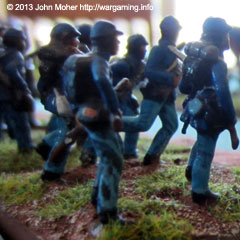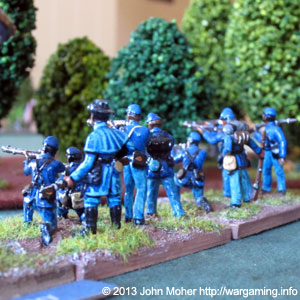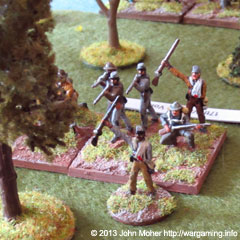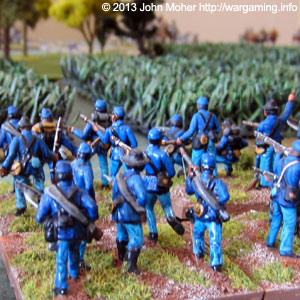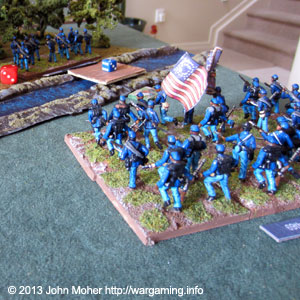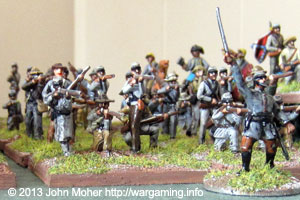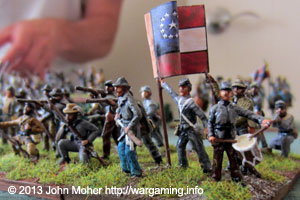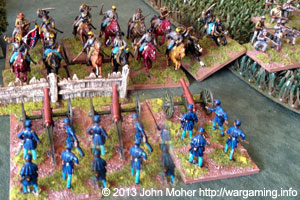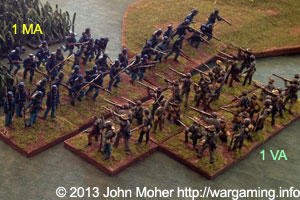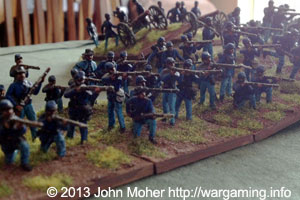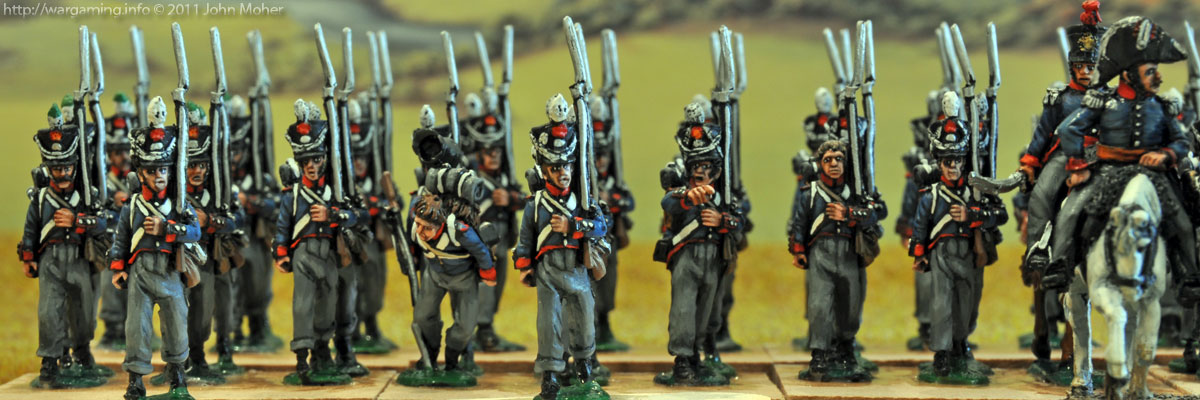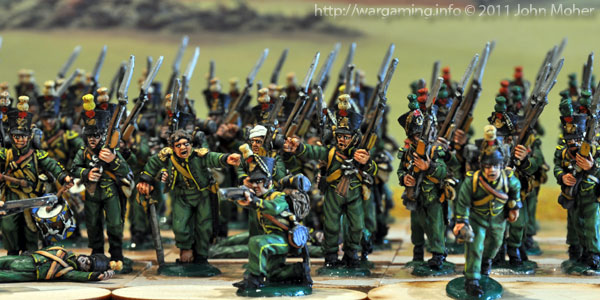Following on from our action on the Gettysburg-Hanover railroad, a major action was fought by the Army of the Potomac against General Lee’s Army of Northern Virginia – this epic 3 day encounter was thought to have decided the war, but as usual the Confederates managed to slip away from us and retire to the safety of Virginia with our pursuit proving cumbersome and erratic. The outstanding performance of our new commander (General Meade) at Gettysburg was somewhat tarred by the escape of Lee and ‘his boys’ and we spent the next two months playing a very ponderous game of cat and mouse around Northern Virginia! However good news had come from the west, at the same as we were at Gettysburg, my namesake General ‘Ulysses’ S. Grant had defeated the rebs at Vicksburg, and finally wrestled control of the mighty Mississippi – the Confederacy was cut in two. Shortly after General Grant was promoted to command of all the U.S. armies and headed east to join us, basing himself with the Army of the Potomac.
Tag: Regiment
Marching On Richmond: Pennsylvania 1863
A few weeks after our defeat at Chancellorsville, as we were reorganising my division as previously described, General Robert E. lee suddenly invaded the north again, this time heading for Pennsylvania! By the time our army was aware of his manoeuvre he had a sizeable head start, but we hurried after him with much greater vigour than previous occasions, heading through Maryland into the heart of Pennsylvania. As we neared the end of June our commander (Joe Hooker) was replaced by yet another new commander, General George Meade was now head of the Army of the Potomac. However meanwhile, unknown to us, General J.E.B. Stuart had taken his cavalry off on a wild raid deep into our territory, effectively leaving the main CSA army blind, and as a result we blundered into him in late June catching up on part of one of his corps, and forcing on them a hasty defensive battle. We were several miles north of a town called Gettysburg, along the Gettysburg-Hanover railroad, and the date was the 30 June 1863.
Marching On Richmond: May 1863
Following our army’s defeat at Chancellorsville and our withdrawal back across the Rappahannock we again had a period of some inactivity, during which we reorganised our forces and received further replacements. My Division were in fairly good spirits (as we had been victorious at the Cornfields), but we had a large number of men who had succumbed to injury, wounds, or illness during the previous campaign, and despite the Summer weather attrition had taken it’s toll. However we had also heard the enemy had suffered a great leadership loss, the great Stonewall Jackson had apparently been shot by his own men (a sad end to a great warrior). It was at this juncture, and in anticipation of a new summer campaign in the coming weeks, that I took the difficult decision of merging some of my regiments, their numbers having fallen to only that of the strength of 1-2 companies, and therefore their combat effectiveness was becoming questionable. To try and reduce the resentment this would cause the regiments that were broken up were sent as replacements to their closest ‘neighbouring’ regiments – in the hope this would smooth the transition.
Marching On Richmond: The Cornfields 1863
After our breaking from winter quarters we began a march once more into Virginia, tasked with joining the balance of the army of the Potomac that had wintered in the vicinity of Fredericksburg, and was now under the command of Maj. Gen. Joseph Hooker. By late April the army was fully assembled and our new commander was preparing to launch his grand offensive, which you will of course now know dear reader culminates in the great battle of Chancellorsville, and we were to be in the vanguard. Setting forth on the last days of April we had crossed the Rappahannock and now pushed our columns forward through the wilderness and outlying Confederate Pickets, and headed South-East, towards the open farmland in the rear of General Lee’s army at Fredericksburg. Sporadic actions developed over these days but it was on the 1 May 1863 that the first serious clashes occurred, and we were involved…
Continue reading “Marching On Richmond: The Cornfields 1863”
Marching On Richmond: Winter 1862
Our action near the Antietam Creek had been disappointing, and we ended up going into winter camp with the gloom of mediocrity over us. However the cheery news was our whole army had given Robert E. Lee a very bloody nose in the greater action – and we soon cheered at the thought of finally ending this whole affair in the coming summer – 1863 would be the year the Union was reconstituted! meanwhile we continue to hear continual news of our nemesis, Brigadier General Longman, through the rumour mill – again his name seems splashed all over the Rebel papers with tales of great daring, while alas there is no such joy for me.
Marching On Richmond: Fall 1862
Having set forth into Maryland in pursuit of General Robert E. Lee we headed North-West as part of the great Union Army, a mighty force of 80,000 or more men that surely would finally end this break in the Union, and restore the country. After two weeks rapid marching through the hills and mountains we came upon the main rebel army, and as our forces converged I was tasked with holding a vital section of river, to ensure the enemy could not use it as a route to slip out of our trap!
During our march rebel cavaliers had been harrying some of our supply columns, cutting or intercepting our telegraph lines, and generally making a nuisance of themselves. As a result as my small Division deployed to its allotted flank guard position I was conscious of the possible presence of enemy raiders in my rear – having no cavalry in my command I had no means either to effectively monitor for their presence.
Marching On Richmond: Late Summer 1862
Following on from our victory at Seven Pines, and the army’s less successful actions in the Seven Days campaign, as mentioned we were then surprisingly withdrawn from the Virginia Peninsula and brought back to Maryland. During this period we received very few reinforcements and had also suffered somewhat from the summer scourge of mosquitoes and other nasties. However before departing the peninsula we had managed to reform the remnants of the 12th New York, although we left behind several of our force.
Marching On Richmond: Summer 1862
As Winter thawed we did much manoeuvring around Maryland but not much became of this, and once Spring arrived we were moved to ports and embarked upon USN transports, destination initially unknown, but later revealed to be the Virginia Peninsula. By late spring we were in Virginia and marching on Richmond confident of victory under our new army commander George B. McClellan. There was minor skirmishing with the Rebels and some brisk actions, but we always stood firm and soon were continuing our irresistible movement North, my brigade was not significantly involved in these actions. we did learn from intelligence gathered that our opponents from last year, Longman’s Brigade, were part of the forces defending Richmond and we may well get a second chance to try conclusions with them… And it was at a place we dubbed Seven Pines that the Confederate’s did launch a surprise counter attack on our forces and this is where I shall take up my story…
Marching On Richmond: Winter 1861
After our previous battle (known as ‘Warrenton Turnpike‘ to us but as the ‘March on Manassas Junction‘ to the Confederate Forces) we spent considerable time manoeuvring and counter-marching, but no further significant action was to arise in the summer of 1861. By Autumn both ourselves and the enemy were busying themselves with establishing winter quarters and stockpiling stores, and receiving reinforcements and additional ordnance. There has been much talk of the last battle, and it’s outcome – news continues to come through from Richmond and elsewhere in the south of the celebrity of my erstwhile opponent dear reader. Colonel A.P.S. Longman is currently the toast of the CSA and if we are to believe everything he may well single-handedly decide this venture, regardless of what any of us may do…!
There has been much change as we get through our fall and winter, shortly after the previously reported major engagement our “Army of Northeastern Virginia” was incorporated, as a Corps, into the new “Army of the Potomac” under one Maj. Gen. George B. McClellan – who seems a fine sort of soldier! Our new Corps remains directly under our old commander from the summer battle, Brig. Gen. Irvin McDowell. In the South we hear that the Confederate “Army of the Potomac” has undergone some changes also – and at the end of winter it is confirmed it has been renamed the “Army of Northern Virginia“.
Marching On Richmond Fast-Play Campaign
Today Cam & I kicked off a fast play ‘style’ ACW Campaign, where we start off in 1861 with an identical sized brigade each, and these will grow and change over the course of our battles, with units being reduced by attrition but gaining in experience (while also losing their élan to a degree with that experience), or being reduced to the level they are disbanded or destroyed on the battlefield, while other units will arrive to reinforce these forces, gradually increasing our commands’ from Brigades to Divisions…
It’s 1861, the United States is at war, with itself! Both North and South have called forth men to defend the sovereign claims. I have been given command of a Brigade of Volunteers in the USA Army of Northeast Virginia, currently the primary force of the Northern Army on the border of Virginia – I am Colonel Ulysses P. Rickards and I am a veteran of the ante-bellum U.S. Army, having served in the Artillery. In the vicinity of my Brigade’s encampment is a Confederate Brigade (that I am charged with observing) of the CSA Army of the Potomac, under one Colonel A.P.S. Longman, like my brigade, Colonel Longman’s is made up of fresh volunteers, and is currently covering one of the main routes into Virginia from Maryland. Colonel Longman is an extremely wealthy Virginia Land Owner, who is very well connected and pre-war was regularly featured in the fourth estate and other media – a celebrity of sorts.
28th Oranien-Nassau Regiment 1815
Continuing with Lieutenant General Hendrik George de Perponcher-Sedlnitsky’s 2nd Dutch-Belgian Division in the Hundred Days campaign and the balance of (Colonel) Prince Bernhard of Sachsen-Weimar-Eisenach’s 2nd (Nassau) Brigade, and following on from the 2nd Nassau-Usingen Regiment is the 28th Oranien-Nassau (Orange-Nassau) Regiment – the unit von Sachsen-Weimar (Saxe-Weimar) was Colonel of prior to taking over the 2nd Brigade on the 15 June 1815. So as these are near completion and following the ‘Work In Progress‘ type photos theme, here’s the Oranien-Nassau regiment…
Continue reading “28th Oranien-Nassau Regiment 1815”2nd Nassau-Usingen Regiment 1815
I have finally got around to getting to work on basing up my figures for Lieutenant General Hendrik George de Perponcher-Sedlnitsky’s 2nd Dutch-Belgian Division in the Hundred Days campaign. First up is (Colonel) Prince Carl Bernhard of Sachsen-Weimar-Eisenach’s (Saxe-Weimar in English) 2nd (Nassau) Brigade, with possibly my absolute favourite uniformed Allied unit from Quatre Bras, the 2nd Nassau-Usingen Regiment. As they are now firmly mounted on bases ready for completion by flocking, varnishing, and fitting of standards I thought it was a good excuse to take some ‘Work In Progress ‘type photos of the near completed regiment…
Continue reading “2nd Nassau-Usingen Regiment 1815”